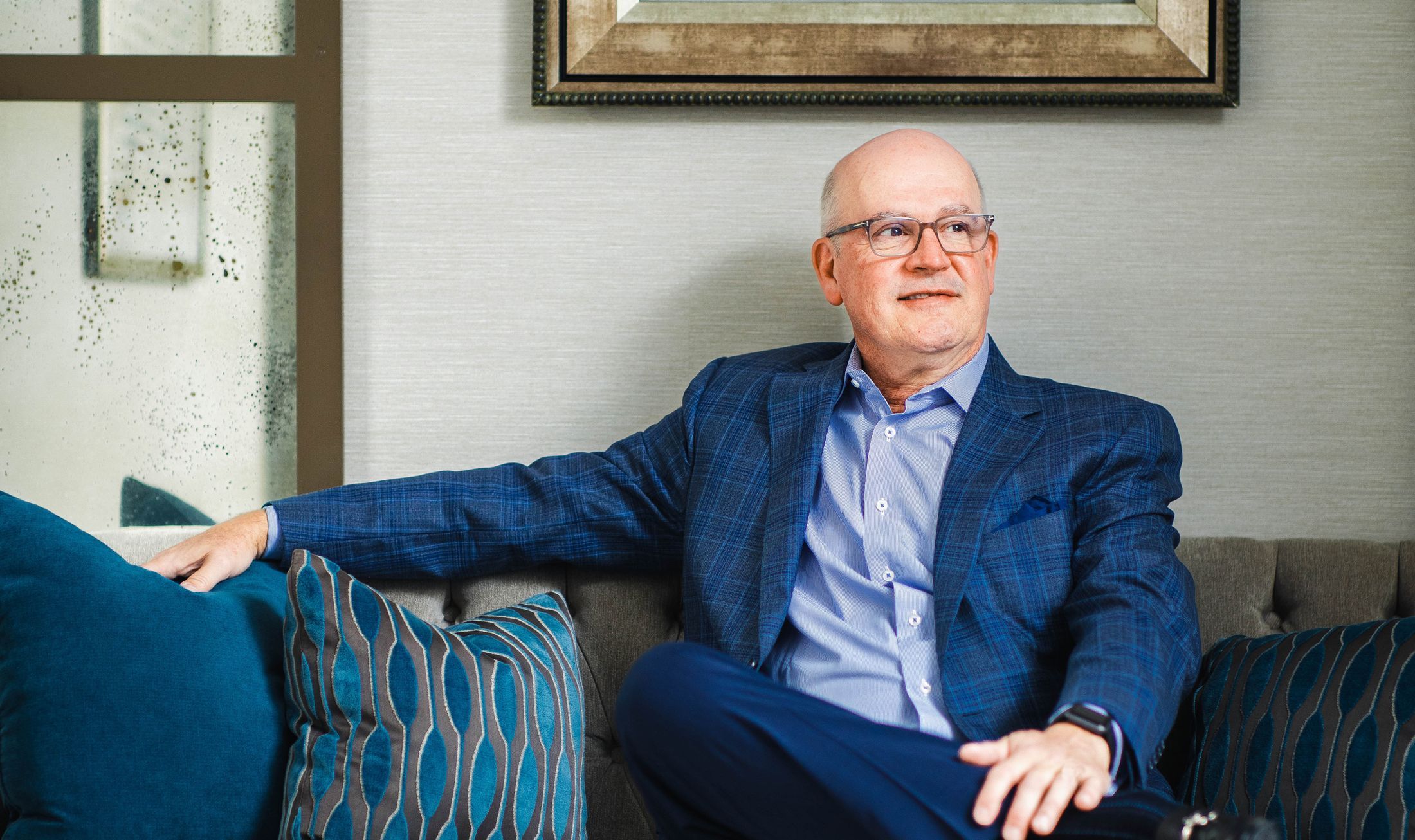Breast Reconstruction in Houston TX

Mastectomies are life-saving surgeries designed to remove breast cancer. While effective, these surgeries often leave women feeling incomplete. Houston plastic surgeon Dr. Leo Lapuerta is a breast reconstruction specialist who works with cancer patients in the greater Houston, Pearland, and Katy, Texas, areas to help them regain their self-confidence following a mastectomy.
His goal is to surgically rebuild the breasts to restore their original appearance by creating a natural shape and contour, while at the same time ensuring they are symmetrical. Dr. Lapuerta will work with the cancer surgeon toward a mutual goal to achieve the best surgical outcome.
1 of 8
“Visit was phenomenal, staff impeccable, and Dr has 10 + bedside manner accompanied with a sense of humor. I will continue to go and refer all my friends.”
Review from L.B. | Source: Google | Aug 04, 2023 Plastic Surgery Patient
When a breast cancer patient undergoes a mastectomy, a surgeon will remove the woman’s entire breast tissue to eradicate cancer or prevent its further spread. This can involve the removal of one or both breasts, depending on the treatment plan. Mastectomy surgeries can be an effective treatment for patients with breast cancer as well as a preventative treatment for those at risk of developing it. A concern that many patients face with this surgery, however, is the end result of removing breast tissue — a flat chest without the appearance of breasts.
Breast reconstruction is a surgical procedure used after a patient has had one or both breasts removed with a mastectomy, usually due to breast cancer. Breast reconstruction surgery after a mastectomy is a procedure that involves rebuilding and reshaping the breasts. Surgeons can provide a patient with the option to reconstruct their breasts with implants or with tissue from other parts of their body. Reconstruction of the breast can give you more self-confidence and help you feel better about the way you look in clothing, especially swimsuits. It also helps you feel whole again after going through cancer treatment.
Two main types of breast construction in Houston, Texas, are available. The first is fat grafting, also called tissue flapping, which takes fat tissue from other areas of the body, remolds it into the shape of a breas,t and inserts it under the skin in the chest. The second is the implant procedure, which uses a breast implant. The surgeon will implant the breast insert into place much the same way as they would with breast augmentation.
To understand your options and determine if breast reconstruction surgery after a mastectomy is right for you, schedule a consultation with Dr. Lapuerta.


Dr. Lapuerta tailors the reconstruction technique according to each patient’s physical health, aesthetic goals, and personal preferences. His ultimate goal is to ensure the patient is healthy and happy with their final breast results. Many factors play into the approach that he takes with each breast reconstruction surgery.
There are two primary categories of breast reconstruction techniques: Procedures that involve using a breast implant and procedures that are autologous, which use the patient’s own body’s tissue to reconstruct and recreate the breast.
Breast reconstruction using silicone or saline implants is a common approach that generally starts with the use of a tissue expander to help form a suitable pocket for an implant. The surgeon may insert an expander after the mastectomy procedure or during the same operative session. Over the course of several months, the expander will slowly be enlarged using a sterile solution injected through a port residing under the skin. Then, during the scheduled reconstruction surgery, the surgeon will remove the expanders and replace them with silicone or saline implants.
One technique for breast reconstruction is fat grafting. The surgeon takes fat tissue from the abdominal area and recreates the breast by inserting it under the skin in the chest area. This type of surgery is often done in place of using breast implants for a more natural feel and look. Fat is chosen from the abdomen because it feels most like the tissue in the breasts.
If there is limited tissue inside the breast or limited skin on the outside, the surgeon may recommend using tissue from another part of the patient’s body, such as the buttocks, thigh, or abdomen, to supplement. This is an autologous approach to breast reconstruction. The TRAM flap (Transverse Rectus Abdominus Myocutaneous), the DIEP flap, and SIEA flap techniques involve taking skin and fat from the abdomen and relocating it to the breast. The latissimus dorsi flap is another common method using tissue from the patient’s back.
Additionally, nipple and areola restoration techniques are often required as part of a breast reconstruction process if the surgeon performing the mastectomy cannot save the nipple and areola. The loss of one’s nipple and areola can be as unnerving as the removal of the breast itself.
However, reconstruction techniques have advanced greatly, allowing plastic surgeons the opportunity to recreate these areas of the breast to give a natural, aesthetically appealing appearance. In a separate procedure, the surgeon creates the nipple using existing breast skin or from the abdominal or back muscle flap.
Using a tattoo technique, the surgeon recreates the areola with a skin graft taken from the thigh, abdomen, or back.
There are several steps and considerations patients should plan for when exploring breast reconstruction surgery.
To start, patients should come to their first consultation regarding breast reconstruction after cancer prepared to discuss where they are in the treatment process and which cancer surgeon provided treatment. Our office will require patients to provide any necessary pathology reports.
Additionally, patients should consider that the reconstruction process may take place in multiple steps if the breast tissue needs to be stretched to make room for implants. This discovery phase will help guide the reconstruction process so patients end up with a new breast that is the size, shape, and look they want.

Before undergoing the actual procedure, the patient will first meet with Dr. Lapuerta to discuss breast reconstruction surgery options. Once they have decided on a treatment plan, the patient attends a pre-operative appointment to further discuss expectations and preparations, before scheduling the surgery.
On the day of the procedure, Dr. Lapuerta will perform the breast reconstruction surgery under general anesthesia at an accredited surgical facility. Preparation for the procedure can take roughly two hours, while the procedure itself may take up to six hours, depending on which technique the surgeon uses.

Multiple surgeries may be required for the reconstruction of the breast, depending on the technique used. If the decision is to use implants, the tissue in the chest must first be expanded to create a pocket to hold the implants. An expander is placed inside the tissue, which continues to expand for several months. Once it has created enough space, another surgery is scheduled to place the implants inside the tissue pocket.
If there isn’t enough tissue left in the breast or the plan was to use fat tissue instead of implants, the surgery will involve removing tissue from elsewhere on the body and attaching it to the chest. Common areas for tissue removal include the abdomen and back. The surgeon may also need to restore the nipple and areola if they couldn’t be saved with the mastectomy. The surgery for breast reconstruction in Houston takes around six hours, depending on the technique used.
You can expect to stay in the hospital for at least two days or up to five days if there are any concerns. When you go home, you may wear a support bra to reduce swelling. You’ll be bandaged to protect the incision areas and reduce the risk of infection.
Once you go home, you’ll be on limited mobility. You can expect to experience swelling and bruising with soreness and pain following the surgery. The doctor may prescribe pain medication to help with the discomfort. It can take up to two months before you can return to all your normal activities, but you’ll begin to notice improvements as the swelling subsides. The doctor will have you schedule follow-up visits to monitor the progression of healing in your breasts. It will be several months before you see the final results of the surgery, but you’ll notice a difference right away at having breasts again.
After surgery, some patients may be required to stay in the hospital to be monitored for complications. Patients who have had reconstruction using a flap technique will usually be required to stay in the hospital for two to five days.
Once Dr. Lapuerta clears the patient to go home, he will provide follow-up instructions and require the patient to attend several post-op appointments. During these appointments, he will assess the patient’s healing, update the treatment plan if necessary, and address any questions and concerns. Patients are sometimes recommended to wear a support bra that encourages healing and reduces swelling.


The recovery process can be somewhat lengthy, but many view it as the final step in their cancer journey and, thus, very rewarding.
It is important for patients to have realistic expectations of their “after.” While the surgeon will do his best to reconstruct and reshape the patient’s breasts, they may not look or feel exactly how they once did in their natural state. Most women are thankful to have had the opportunity to restore their breasts and are satisfied with their results.
Recovery itself will include immediate swelling, bruising, and soreness following surgery, It can take at least two months until the patient can comfortably return to normal activities. They may also experience limited mobility and restricted movements until they fully heal. The surgeon will likely prescribe pain medications to help ease the pain.
The results of breast reconstruction can be life-changing. Women often feel a renewed sense of confidence and wholeness, with a restored breast that looks and feels natural. Whether you choose an implant-based procedure or flap reconstruction, Dr. Lapuerta ensures results that align with your unique anatomy and personal vision.
Reconstructed breasts are long-lasting and durable, allowing you to enjoy your results for many years. With proper care and regular check-ins, you can feel confident in your appearance and the quality of your outcome.

Having performed more than 20,000 surgical procedures, Dr. Lapuerta has over two decades of professional experience for breast reconstruction in Houston. He has performed hundreds of procedures involving the breasts, such as breast augmentation and breast lift. Dr. Lapuerta is also experienced in handling issues that arise from breast surgery, including breast implant revision and capsular contracture treatment. He will discuss your health, concerns, and goals to help you decide if undergoing breast reconstruction surgery after cancer is an option for you.
For those interested in learning more about breast reconstruction surgery options, schedule a Consultation with Dr. Lapuerta.

Recovery time
Average Procedure time
Post-op Follow-up
Procedure Recovery Location
1-3 Weeks
2-6 Hours
1 Week
In & Outpatient

When you decide to have breast reconstruction in Houston, TX, your first step will be to schedule a consultation with Dr. Lapuerta. He will perform a physical exam and review your medical history to determine if you’re a good candidate for surgery. During this consultation, he’ll discuss options for reconstructing the breast and what you can expect during the process.
Breast reconstruction requires at least two or three surgeries to get the final results you want. The exact procedure will depend on the type of surgery chosen by you and your doctor. Your breast reconstruction surgeon in Houston will explain the process during your consultation. The first surgery creates the new breast, while the second and future surgeries will focus on making any necessary changes.
If you had a mastectomy on one breast, your natural breast may require surgery to match the reconstructed breast. For instance, it may need a breast lift to be at the same level as the reconstructed one. You might need to have the size increased with breast augmentation or decreased with breast reduction to match the newly formed breast.
The final surgery will recreate the nipple and areola. It’s done separately from the other reconstruction surgeries to allow the breast to fall into place and any refinements to be completed. These additional surgeries are usually performed two to three months after the initial surgery to allow for healing. The doctor performing the surgery for breast reconstruction in Houston will discuss the number of surgeries you’ll need, along with an estimated timeline during your consultation. Feel free to ask questions about the process until you feel comfortable with the plan.
In many situations, it is recommended to start the reconstruction process at the same time as the mastectomy. Therefore, it is a good idea to have your breast cancer surgeon and your plastic surgeon begin communicating about the steps that will follow. An advantage of doing the procedure immediately is waking up from your mastectomy surgery with the reconstruction process in place. The soft tissue that surrounds the breast will heal simultaneously with the reconstruction, which can enhance the final results.
In some situations, it may be advisable to delay the reconstruction. If your oncologist recommends radiation, the reconstruction surgery should wait. Radiation can affect the breast flap that will be used in the surgery. Once all treatments have been completed, they can discuss reconstruction with you.
You can also choose to delay the surgery if you want to focus on recovering from the mastectomy first.
You may wonder, “How painful is delayed breast reconstruction?” Fortunately, the surgery can be done at any time, even years later after a mastectomy. Delaying reconstruction does allow the initial surgery to heal and for you to complete any additional treatments. To learn more about Houston breast reconstruction, you can discuss your options in a consultation with Dr. Lapuerta.
The Women’s Health and Cancer Rights Act of 1997 has made it possible for many women to undergo breast reconstruction surgery without the burden of a heavy financial cost. The act states that insurance companies and managed care organizations are required to pay for breast reconstruction for women who have had a mastectomy. It supports all phases of the cancer treatment and reconstruction process. Dr. Lapuerta’s insurance and billing office will work with the provider to understand exactly what the coverage will be.
For those interested in learning more about breast reconstruction surgery options, schedule a consultation with Dr. Lapuerta. Having performed more than 30,000 surgical procedures, Dr. Lapuerta has over two decades of professional experience. He will discuss your health, concerns, and goals to help you decide if undergoing breast reconstruction surgery after cancer is an option for you.
To find the best breast reconstruction surgeons, you’ll want to look for someone with experience in this type of surgery. Even if they have worked with other breast procedures, you want a surgeon who has performed many reconstructive surgeries. Ask for before and after photos where you can see how the reconstructed breast looks.
Once you have selected a surgeon, you’ll want to schedule a consultation. Don’t be afraid to ask questions about your options for breast reconstruction and recovery.
This is a very specialized surgery that requires extensive knowledge, skill, and experience. It is very important to research and find a qualified and reputable plastic surgeon who has experience with breast reconstruction surgery. You can ask to see before and after photos to help you feel more confident about the surgeon’s experience and skill, read reviews online, and ask your primary healthcare provider to make a recommendation in their community.
A reconstructed breast will not have the same sensation as the breast did before the mastectomy. However, over time, some of this sensation will return to normal. This will depend on the extent of the reconstruction process and will vary by patient. It may also depend on the type of reconstruction you have done. Skin and nipple sparing mastectomies focus on leaving as much of the breast skin and nipple area intact as possible, which will preserve much of the sensation. Your cancer doctor will help you determine which type of mastectomy is right to ensure all of the cancer cells are removed while doing the least damage to your breast area.
The two main types of breast reconstruction in Houston, TX, are implant reconstruction and flap reconstruction, also known as tissue reconstruction. Implant reconstruction uses saline or silicone implants to create a new breast. Flap reconstruction takes fat tissue from elsewhere on your body and uses it to create a new breast. These two procedures can be performed together to recreate a breast. Dr. Lapuerta will discuss the technique he advises when you meet with him for a consultation.